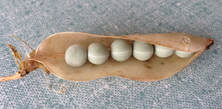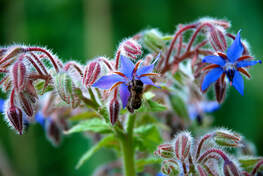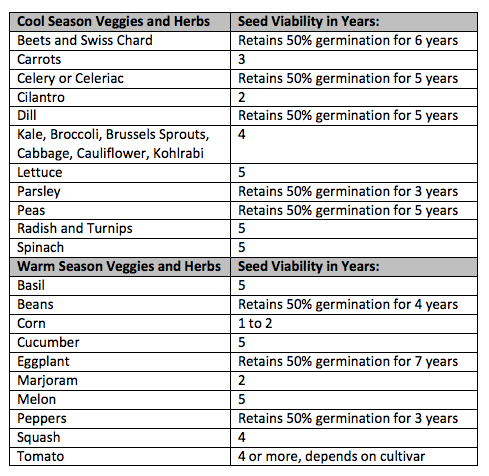
Any seeds, whether store bought or saved from your garden, should be stored in a cool, dark, dry place. Keeping them in the freezer is not required and may do more harm than good.
Before storing seeds that you harvested from your garden, they need to be completely dry. You may want to keep them in airtight containers, but paper envelopes work fine as well.
How long can you store seeds?
Vegetable seeds have different viability. You can keep seeds longer than the suggested seed viability time, but you will need to plant more, as many of the seeds will no longer germinate. Here is a table with the seed viability of some common vegetables seeds. This info is from Edible Plants for Prairie Gardens by June Flanagan.

Instead of saving seed and controlling where plants grow, some people allow some plants to self-seed. The seeds fall on the ground or are carried to a new location by wind or birds. These can take over a garden if you do not pull some, although they only reproduce by seed.
Some of these may include:
- Cilantro
- Parsley
- Dill
- Lettuce
- Arugula
- Borage (see image)
- Buckwheat
- Sunflowers
- Sunberries (black berries related to tomato) – very prolific and rather invasive
- Pot Marigold (Calendula)
Which seeds can you save?
You can save seeds from heritage or open-pollinated vegetables. Seeds from Hybrids may grow but the plant will likely not produce fruit with the same characteristics you had in the first year.
Easy Seeds to Save
• Legumes – beans, runner beans, peas, fava beans, chick peas, soy beans, lentils
The plants naturally lose their leaves until only the pods are left. The beans may even rattle in the pods, but may also pop open. Pick the dry pods and dry them out in your house for a few days. Then pop them open to remove the seeds or gently step on them to release the seeds. Place them in paper bags or small, labeled envelopes. Store in a cool, dry and dark place.
• Lettuce and Arugula
Allow the plant to ‘bolt’ and grow upwards. It will produce a flowering stalk with tiny yellow flowers. The seeds develop a small parachute similar to dandelions. Pick off some of the fluffy seeds and drop them in a paper bag. Then shake or rub the seed heads to separate the white or black seeds from the fluff. Label and store.
• Tomato and Cucumber
Pick a very ripe tomato (or an over-ripe, yellow cucumber) and cut or squirt the seeds into a glass. Add a little bit of water and let this ferment for about 3 days until the water is a bit bubbly. Rinse the seeds into a sieve and wash off the gelatinous covering. Place them on a screen or on a towel for drying. Make sure they are very dry before storing.
• Pepper, Eggplant, Melons and Squash
Scoop the seeds onto a drying screen or towel to dry. Wash first if necessary. Make sure they are very dry before storing. Note: Melons and Squash may cross-pollinate with other types and produce unexpected results.
More Challenging Seeds to Save
Seeds from vegetables such as carrots and beets are more challenging, as the plant needs to be kept over winter and replanted to get seed in the second season. In small yards and with our very cold winters, most casual gardeners will leave saving these seeds to the experts.
More Information
For detailed information on saving specific seeds and important reasons for saving your own seed, you can find good information on the website by Dan Jason from Salt Spring Seeds.
You can also visit The Seed Savers Exchange website. Another website to check out is: http://www.seedsave.org

 RSS Feed
RSS Feed